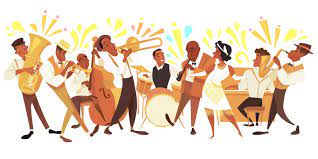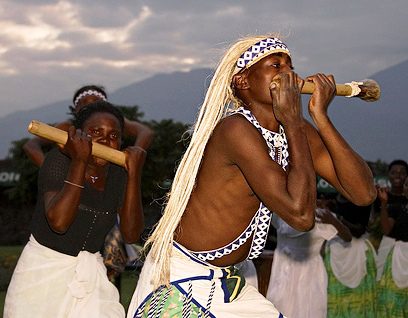Music from Africa to America

By: Leah Robinson
By the Rivers of Babylon
Africans new to America bound by the shackles of slavery sang "the LORD'S song in a strange land" by coming up with creative ways to produce music without instruments. They performed pattin' juba and hambone and used their bodies and voices to create music. They also used call and response and ring shout to express their feelings and beliefs in musical ways. The also took European style music and made it their own through the use of syncopation and polyrhythm. Many slaves arriving to the new world sang sorrow songs as they left their home countries. On the slave ships, many Africans joined together to sing sorrowful songs about leaving their homeland. Singing was how slaves expressed themselves and many work songs developed as a way to not only keep the minds of the enslaved busy but also to upkeep the pace of work. There were also warning songs in which slaves would sing in code to warn other slaves of danger or inform other slaves on the status of the master. "By the Rivers of Babylon" appears to be a sorrow song. The slaves express their wonder for how they are supposed to sing songs they sang in their home countries in a new and foreign land.

Role of music in African/African American communities:
In African communities, music was a necessity for all major events including life cycles. Life cycle events included events like birth, marriage, or even death. Music was a very important part of many traditional West and Central African cultures. Our use of music even dates back to royal courts where Kings would hire an ensemble of musicians to play for numerous occasions. During slavery, many Africans would sing while working to get rid of boredom, pass the time, or keep up the steady pace of work. Slaves were not allowed to use instruments, especially drums, out of the owners fear of a rebellion so slaves were forced to use only their bodies and voices to create their music. Music also became a very important part of all healing and religious rituals. For example, Mrs. Roger A Pryor, the wife of a confederate officer, describes her experience watching salves create music after the death of one of the slaves on their plantation. Music in African and African American communities creates a "sense of aliveness" as Africans/African Americans are very vocal and expressive when they feel the power and passion behind a musical artist.
The ways music is created, performed, and experienced:
The musical process is defined as the way music is created, performed, and experienced. Because Africans were not allowed to use instruments to create music during slavery, many created music that involved singing, dancing, clapping hands, and stomping feet. Traditionally during a funeral, Africans would often beat on the drum on the way to the burial site. Upon arrival, they would march around the grave in a ring, beat on their drums, and shout. There is also the call and response style of music in which the main singer will sing out a lyric and the chorus will respond back. Slaves also brought instruments with them from Africa including the banjar, banjo, djembe, gourd, and fiddle. Because they had limited access to resources, slaves got creative and used what was given to them by their masters to create new versions of instruments they had to leave behind in Africa. For example, the washboard could be recreated using a tin can and a hair pick. Music was detrimental to preserving the sanity of slaves and was often very important in keeping slaves on the plantation safe and up to speed with the demands of the slave owner. Music was a time for slaves to recover and connect with the other slaves on their plantation.

The difference in timbre between Africans/African Americans and Europeans:
The structural characteristics and musical processes differ tremendously compared to European music. The differences between Black and European music included the styles of execution and the interpretation of performance. Europeans often called African music wild, crude, strange, weird and classified it as noise. They were also unfamiliar with instruments such as the banjo, guitar, jug, harmonica, and kazoo as these instruments were not traditional in the Western world. In African music, the blend of the banjo, piano, clarinet, trumpet, and tuba created contrasting but unique timbres and textures, much of which Europeans were not used to. Furthermore, rhythm is the African equivalent to the European harmony and Blacks turned European folk songs into their own original songs.
Most common musical structures in African/African American music:
The most prominent feature in African/African American music is rhythm complexity. In Black music, rhythm has a higher importance and significance than melody. Syncopation was very important to black music and getting a unique sound apart from the standard Western sound. Syncopation is shifting the accent on stressed beats to atypical or random stressed points. It gives black music its own uniqueness. Polyrhythm also contributes to black musical uniqueness by combining different rhythms together, also by assigning numerous timbers with different rhythmic patterns as well. African music is more complex than what meets the ear due to its timbre. There are layers underneath layers of different beats and rhythms when it comes to African music.


